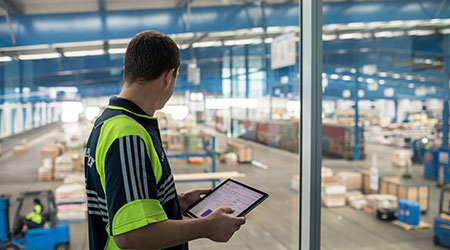SPONSORED
Schneider Electric - Branded Feature
The Driving Need for Industrial Edge Data Centers
We are now well-entrenched in the Industry 4.0 era, or the 4th Industrial Revolution, and are seeing advancements in technology that will require increasingly greater computing power at the network edge, driving the need for industrial edge data centers.
A couple of examples that illustrate the sort of technology evolutions that are driving the need for edge data centers are GPS systems and robots.
GPS gets smarter
In their book "Human + Machine: Reimagining Work in the Age of AI," authors Paul R. Daugherty and H. James Wilson note the first online maps were for the most part digital versions of paper maps.
Pretty soon GPS navigation devices changed the game, giving us directions to any destination in real time. Even that, they point out, was a fairly static process: you enter a destination and the GPS tells you how to get there from where you are.
But today we've got mobile applications such as Waze that take into account all sorts of other criteria when making navigation decisions - traffic, construction delays, accidents and the like. Such apps update in real-time based on the latest crowd-sourced information; Waze may well change its mind as to the quickest route to your destination if conditions along the way change while you're en-route.
As you can imagine, providing all that real-time information requires a fair amount of compute power, much more so than putting a digital map on a website. And much of it needs to be localized, to collect data from thousands of phones employing Waze at any given time. (Right now, Waze tells me there's more than 47,000 "Wazers" around me.) Relying on a central cloud-based data center would likely introduce too much latency for the app to function effectively, hence the need for a series of edge data centers.
Robots get collaborative
Robots have gone through a similar transformation. Once they were used in industries such as auto manufacturing to perform simple, repetitive tasks once performed by (profoundly bored) humans. But that is rapidly changing, as a recent story on the Internet of Business website makes clear.
"A new wave of factory automation is underway and robots are entering new environments and creating new value for manufacturers. In part, this trend is driven by the availability of collaborative robots, or ‘cobots', that are cheaper, more mobile and more flexible than their predecessors and that can work safely alongside human colleagues," the story says.
Robots outfitted with artificial intelligence applications can work alongside humans, analyzing what the human is doing and helping with the task when necessary. Over time, the robot can help the human work in a more productive fashion.

It's not just robots, of course. All kinds of AI applications are being applied to the factory floor, with profoundly positive results. A recent story in arstechnica sums it up nicely:
"Companies are seeing more precise, higher quality manufacturing with lowered operational costs; less downtime because of predictive maintenance and intelligence in the supply chain; and fewer injuries on factory floors because of more adaptable equipment. And outside of the factory, other industries could benefit from having a nervous system of sensors, analytics to process ‘lakes' of data, and just-in-time responses to emergent issues—aviation, energy, logistics, and many other businesses that rely on reliable, predictable things could also get a boost."
Building the industrial edge data center
Here again, the real-time nature of these applications demands data be stored and analyzed as close as possible to where it's produced. Latency is the enemy and a round-trip to a cloud data center and back likely won't be tolerated.
So, it's clear that as we get deeper into the Industry 4.0 era, we're going to see increased demand for industrial edge data centers. Some will be relatively large facilities housed inside manufacturing plants, others small micro data centers located outdoors in remote environments - and everything in between.
Schneider Electric, of course, offers an array of micro data center solutions that are intended for edge environments, as well as numerous partnerships with IT vendors for compute, storage and networking components. The company's recent merger with AVEVA adds powerful analytics software for commercial and industrial environments, such as for predictive analytics.
Learn more about industrial edge computing
The digitization of industrial processes means that data that did not exist before is now accessible. New ways are being devised to both gather and analyze that data. In many cases, the computation of that data is happening in or around local devices (a concept referred to as edge computing). How much of that data is processed locally will depend on both security risks and on latency, bandwidth and process reliability issues.
The disruptive nature of digitization around the "industrial edge" (the places where digitized industrial assets and human operators are located) means that industrial stakeholders will need to think differently in order to devise new ways of capturing unique digitization-driven business opportunities. One example of this new thinking emerged as one of Schneider Electric's customers recently upgraded their manufacturing plant. As their legacy system transformed to digital, four critical success factors emerged: high availability, backup and recovery, power protection and security.

As industrial organizations digitize, attention now focuses on how best to protect industrial edge systems from threats to business continuity. An important challenge for Schneider Electric's customers is to ensure system uptime. Events such as unexpected power outages and other forms of unscheduled downtime disrupt production. In extreme cases, downtime can irreparably damage the reputation of the manufacturer. In order to minimize such risks, planners, designers and installers of industrial edge solutions should consider the following actions:
1. Ensuring high availability of edge applications
A major competitive differentiator is a company's ability to quickly respond to customer needs and requirements. Information Technology (IT) and Operations Technology (OT) edge compute systems should be designed to maximize systems availability. Understanding the trade-off between investments in redundancies (in order to enhance availability) and the risks of downtime becomes a critical success factor in a connected world.
2. Integrating a backup and recovery plan
When disaster strikes (natural or otherwise), how quickly can industrial edge operations be brought back on-line? Does the business continuity plan account for partial or total loss of digitalized edge assets? When new edge compute applications are installed, oftentimes disaster recovery plans are not taken into account. In the age of advanced connectivity, systems downtime can often have an unexpected cascading effect on operations. Proper business continuity planning can eliminate much of this risk.
3. Investing in proper power protection
Power systems such as uninterruptible power supplies (UPSs), power distribution units (PDUs), circuit breakers, automatic transfer switches, isolation transformers, and generators are designed to provide uninterrupted, conditioned, clean power to the critical loads. These systems feed and protect a variety of electrical loads including lighting, heating, ventilation air-conditioning (HVAC) systems, elevators, large pumps, fans, motors, security systems, specialized machinery equipment and more.
4. Implementing a physically secure and cybersecure edge
Cybersecurity starts with physical security. The risks of cybersecurity breaches can be mitigated in a number of ways, but if processing and storage hardware is not physically secure it is vulnerable to malicious or unintended tampering. As a result, data may be compromised. Developing industrial edge physical security and cybersecurity best practices should involve both OT and IT experts and solutions that have attained proper cybersecurity certifications.
Access edge computing white paper
Industrial organizations faced with the challenge of properly securing their industrial edge applications can engage engineering experts to perform complete physical infrastructure assessments that both identify business continuity exposures and power protection best practices. Access our white paper "The Drivers and Benefits of Edge Computing," to learn more about the benefits of adopting an edge computing solution.
What's the business value of an IIoT edge strategy?: https://www.youtube.com/watch?v=1R2Rm-YI0U4
The Drivers and Benefits of Edge Computing: https://www.youtube.com/watch?v=VeKdelK9_B8&feature=youtu.be










